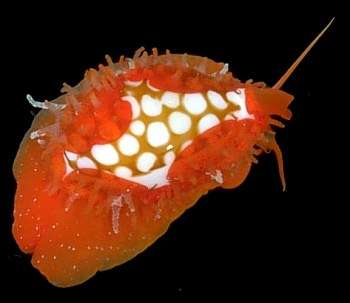
Cowries or cypraeids
Superfamily: CYPRAEOIDEA
Family: Cypraeidae
PHOTO
Cypraea cribraria. The mantle flaps are partially retracted to show the white spotted pattern on the shell. Note the long tapering head tentacles on the right and the right eye at the base of the stalk. Koumac, New Caledonia, October 1993. PHOTO: Bill Rudman.
Cowry shells are a favourite group for shell collectors because of the large variety of shiny coloured shells found witin the family. However in the living animal these brightly coloured shells are usually hidden by two flaps of the mantle. In some cases the mantle flaps are brightly coloured, as in the photo above, but often they are dull mottled colours with branching papillae, making the animal highly camouflaged. There are two main feeding divisions within the family, one group feeding on sponges while the other group are herbivores. Like the ovulids or false cowries they look superficially like sea slugs, especially when the shell is hidden.
Authorship detailsRudman, W.B., 2000 (March 1) Cowries or cypraeids. [In] Sea Slug Forum. Australian Museum, Sydney. Available from http://www.seaslugforum.net/find/cowries
Related messages
Unknown yellow slug
April 2, 2008
From: Stefan Vogel
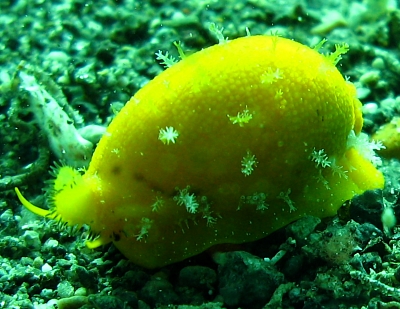
Hi Bill
I just discovered your forum - it's amazing! I would be happy if you could help me to identify some "things" i have seen. I couldn't find this yellow one in any book.
Locality: Kalabahi, 12 meters, Alor, Indonesia, Indian Ocean, 10 May 2007, muddy. Length: 5-8mm. Photographer: Stefan Vogel.
Thank you!
Stefan Vogel
vogel2001@bluemail.ch
Vogel, S., 2008 (Apr 2) Unknown yellow slug. [Message in] Sea Slug Forum. Australian Museum, Sydney. Available from http://www.seaslugforum.net/find/20955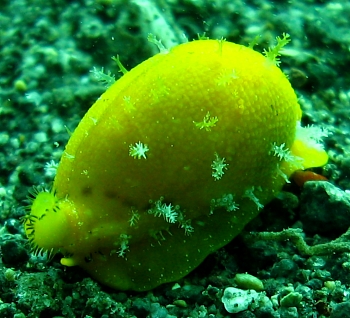
Dear Stefan,
This looks 'slug-like' but it is in fact a 'snail' with flaps of skin which fold up and enclose the shell. It is probably a species of Cypraea, a group which is better known from their beautiful shells, which are known as Cowrie Shells. Have a look at the Fact Sheet and the attached messages for more information. I am sorry I can't make an attempt to identify your animal to species, but I am overwhelmed with sea slug inquiries, and so unable to expand into other areas.
Best wishes,
Bill Rudman
Re: Cowry? from Townsville, Queensland
August 21, 2007
From: Melanie Wood
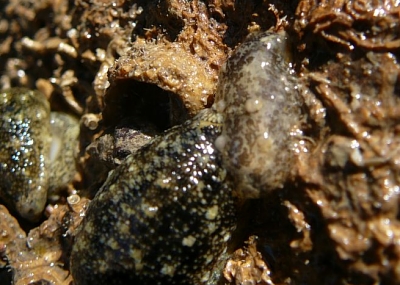
Concerning message #20196:
Hi again,
I did try to find them a couple of weeks later to do exactly that but they went into hiding on me, I am hoping that I will be able to find them again at the next set of low tides.
On the bottom photo (the bottom animal) it is definitely a cowry (Cypraea arabica I believe) with its mantle across the top of the shell - there are a number of them in the area and there was a pair of them under the rock. The little nudibranch (?) was sitting above it for this photo but by itself for the top picture. However, the one above was definitely not a cowry as I did handle it to see. Hopefully next time I will be able to obtain pictures to ID.
Locality: Rowes Bay, Townsville, Queensland, Australia, Intertidal muddy. Photographer: Melanie Wood.
Cheers
Mel
gizmel@yahoo.com
Wood, M. J., 2007 (Aug 21) Re: Cowry? from Townsville, Queensland. [Message in] Sea Slug Forum. Australian Museum, Sydney. Available from http://www.seaslugforum.net/find/20514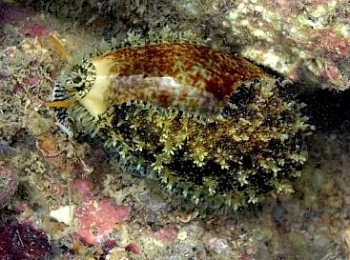
Dear Mel,
Thanks for your reply - glad to see what I thought was a cowrie was in fact a cowrie, but puzzled that the one above wasn't. Good luck with your next look in the mud
Best wishes,
Bill Rudman
Cowry? from Townsville, Queensland
August 17, 2007
From: Melanie Wood
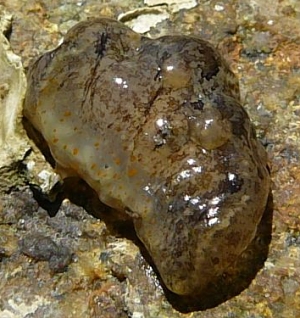
Hi,
I was hoping for some help with the identification of this nudibranch I have seen a few times in the Rowes Bay area. It is quite a small size and looks just like a little blob. The photographs do not show it in 'all its glory' as the only time I could see it fully was while in muddy water. I believe it may have had a small internal shell but am unsure on that fact as it was hard to tell.
Locality: Rowes Bay, Townsville, Low tide (0.47metres), Queensland, Australia, 11 July 2007, Intertidal muddy area, under rocks. Length: 1.5 cm. Photographer: Melanie Wood.
Thanks
Melanie
melanie.wood@jcu.edu.au
Wood, M. J., 2007 (Aug 17) Cowry? from Townsville, Queensland. [Message in] Sea Slug Forum. Australian Museum, Sydney. Available from http://www.seaslugforum.net/find/20196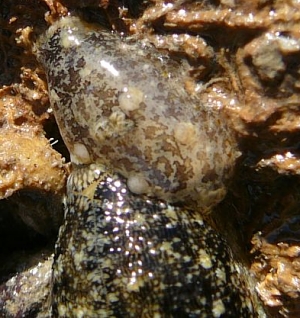
Dear Mel,
It is usually easier to put an animal like this into a pool, or dish, of seawater and see what it looks like when it is in its 'normal' surroundings. At low tide, all these animals are trying to do is stay wet and not dry out so they curl up. In the lower photo the bottom animal seems to have a gap down the midline, suggesting it has a flap of skin on each side which is folded up. Have a look at the Cowry Fact Sheet as I suspect that is what it is.
Next time you see one of these put it in a pool - or have a little plastic container of sea water - and pop it in for a few minutes. It's head should extend out and if these are flaps, they will probably contract a bit to show a bit of the shell.
Best wishes,
Bill Rudman
Mystery 'Slug' from Florida
April 15, 2003
From: Bryan Thompson
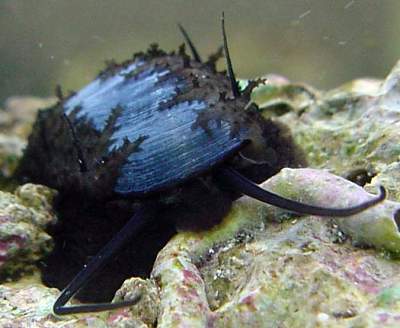
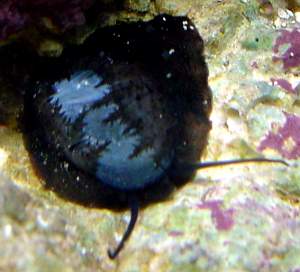
This slug was found in one of my holding tanks. This tank contains mainly stuff from Florida but does have other coral in it. It has no hard shell and is very quick. I would like to know the name and more importantly what it eats.
Thank you,
Bryan Thompson
bryan@blowfishaquatics.com
Thompson, B., 2003 (Apr 15) Mystery 'Slug' from Florida. [Message in] Sea Slug Forum. Australian Museum, Sydney. Available from http://www.seaslugforum.net/find/9641
Dear Bryan,
The whitish thing in your photo is a shell, although only lightly calcified. The tentacles identify this as a caenogastropod snail, but as you give no indication of size its a bit hard to know if this is a juvenile or not. I have discussed this with my colleagues in Sydney and we wavered between a velutinid or a juvenile cowry. Jim Mclean at the Los Angeles County Museum is sure it is a juvenile cowry [Cypraeidae]. He notes "Lindsey Groves knows cowries well enough to say that a black mantle is known for the genus Luria, which includes L. isabella among others".
Concerning what it eats. I'm not a cowry expert but I suspect it is a sponge feeder. I am afraid I must be strong and not allow the Forum to venture far outside the field of opisthobranchs.
Best wishes,
Bill Rudman
Can you identify this?
May 31, 2000
From: Noel Conlon

Dear Bill,
Can you identify this for me please.
It was off Oak Park, Cronulla, [Sydney, NSW, Australia. The long 'fingers' on its back were 1-2 cm . In five meters of water.
Thanks,
Noel Conlon
diannoel@hotmail.com
Conlon, N., 2000 (May 31) Can you identify this?. [Message in] Sea Slug Forum. Australian Museum, Sydney. Available from http://www.seaslugforum.net/find/2471Dear Noel,
It certainly looks like a nudibranch but it is a cowry, a group of snails with brightly coloured shells, favoured by collectors. have a look at the top of the page for some background information.
I am pretty sure the species of cowry is Cypraea limacina.
Best wishes,
Bill Rudman.
Sea slug with internal shell
March 2, 2000
From: David Freemantle
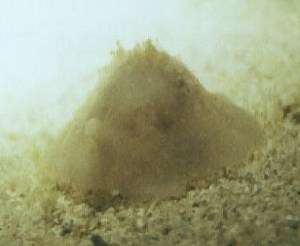
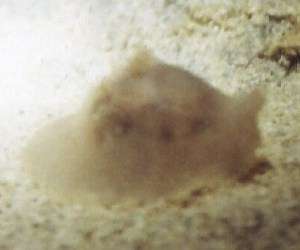
Hi Bill
Could you please help me to identify the sea slug in the attached photo, taken on a pylon (1M) at Rockingham jetty, Perth, Western Australia at night, 27-02-00. The animal is about 2 cm long and has a dark internal shell. Sorry about the quality of the shots.
Thanks in advance.
David Freemantle
scubadav@rock.upnaway.com
Freemantle, D., 2000 (Mar 2) Sea slug with internal shell. [Message in] Sea Slug Forum. Australian Museum, Sydney. Available from http://www.seaslugforum.net/find/1995Dear David,
This is not a slug with an internal shell but a snail with an internal shell. Some snails have flaps of skin which partially or fully enclose the shell. In the Cowries (Family Cypraeidae) and the false Cowries (Family Ovulidae), the flaps of skin can retract to expose the shell but in the Velutinidae the flaps are usually permanent the flattened shell being partially or completely enclosed.
Your question has made me prepare pages on the cowries and false cowries so have a look at the three relevant pages for some background information. I first thought your animal was a velutinid, but your mention of a dark visible shell makes me think you have a cowry. Unfortunately I can't make out enough detail to be sure.
Best wishes,
Bill Rudman.
